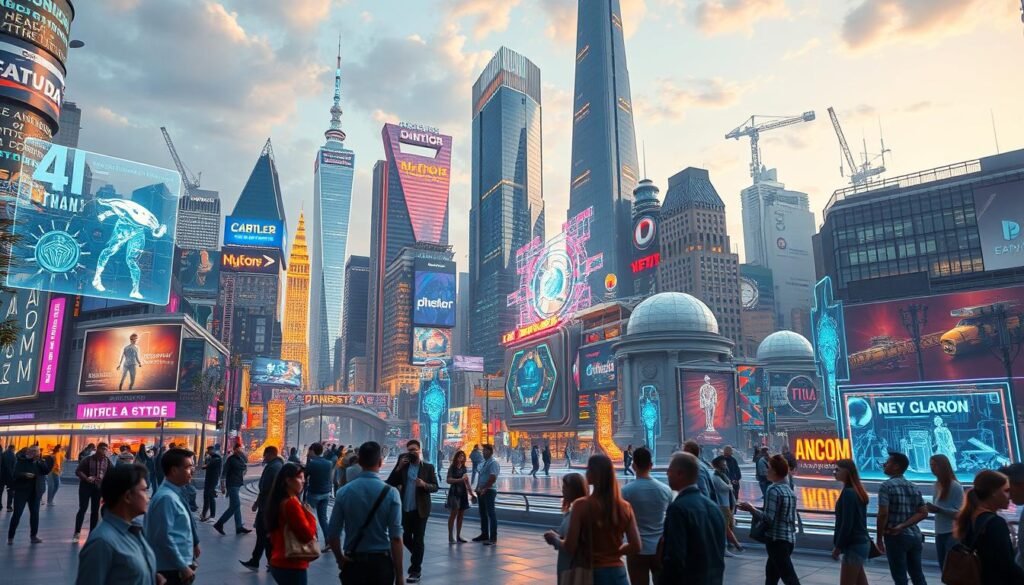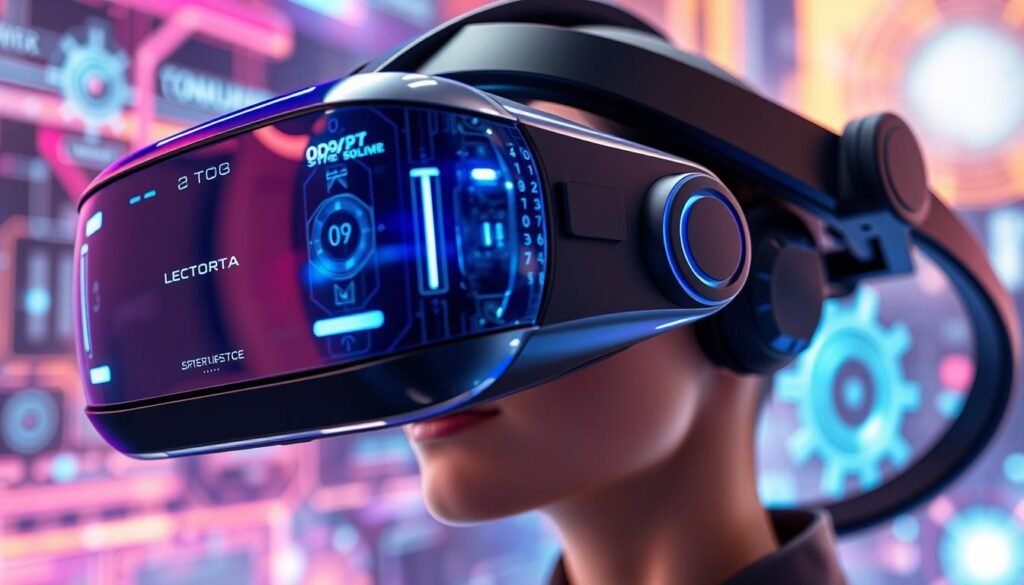AI and Augmented Reality: The Future of Immersive Experiences
Did you know AI, Augmented Reality (AR) and VR’s market value was $15.3 billion in 2020? It’s expected to hit $198 billion by 20251. As we enter 2024, the world of immersive experiences is getting more exciting and full of possibilities2. AI and AR are changing how we see and interact with the world, mixing the digital and physical in new ways.
AI and AR together are making experiences richer, more personal, and more interactive. For example, AR adds digital info to the real world, making interactions better2. AI also helps by adding features like real-time language translation, as seen in Meta’s Ray-Ban glasses1.
This mix of AI and AR is not just for fun. It’s changing entertainment, education, retail, and healthcare. AI has even helped Netflix keep more subscribers, and the Smithsonian is using AI for better virtual tours3. The future of AR tech looks both exciting and groundbreaking.
Key Takeaways
- The AR and VR market is projected to grow from $15.3 billion in 2020 to $198 billion by 20251.
- AI enhances AR by enabling real-time language translation and visual prompts in smart glasses1.
- Netflix’s AI usage leads to a 35% reduction in subscriber churn, showing AI’s power in keeping users engaged3.
- AR overlays digital info on the real world, opening up new ways to interact2.
- AI and AR together are changing many fields, including healthcare, education, and retail23.
Understanding the Basics of AI and Augmented Reality
Artificial intelligence (AI) and augmented reality (AR) are changing how we see the world. AI lets machines think and solve problems like humans, making them smarter4. AR adds digital info to our real world, making things more vivid4.
Defining Artificial Intelligence
AI is about making computers think like us. It helps them recognize objects, understand speech, and learn from data4. Companies use AI to make things better and save money. For example, Google and OpenAI are making AI smarter with new models5.
Exploring Augmented Reality Technology
AR is making marketing more fun and personal. It mixes digital and real worlds, making people more engaged6. Big names use AR to make experiences better, leading to more sales6. AI helps make AR smarter, like Onirix’s Smart Spaces for retail and tourism5.
Knowing about AI and AR helps companies stay ahead. They can use these techs to change how they work and interact with customers.
How AI Enhances AR Technology
Artificial Intelligence (AI) makes Augmented Reality (AR) better by using advanced machine learning and computer vision. These technologies improve AR software’s accuracy and effectiveness. This gives users more immersive and personalized experiences.
Role of Machine Learning in AR
Machine learning is a key part of AI. It helps AR software get better over time by learning from data. This lets AR apps tailor experiences to users, making them more enjoyable.
A report shows 71% of people want personalized interactions from companies. And 76% get upset if they don’t get it7. AI is changing retail by letting customers try on clothes virtually and see products before buying7. These changes show how AI makes AR more useful.
Computer Vision and Its Impact on AR
Computer vision is a big part of AI that helps AR understand the world visually. It makes the real world better with digital info. AI-powered AR can spot and track things in real time, which is great for gaming, retail, and navigation8.
For example, AI and computer vision help AR show personalized product suggestions and virtual try-ons. This makes shopping better9. AI also helps in healthcare by guiding surgeons during tough operations8.
The mix of machine learning and computer vision in AR is a big step forward. It makes our digital interactions better and more productive. This sets a new standard for experiences in many fields8.
Applications of AI and AR in Various Industries
The mix of AI applications and augmented reality (AR) is changing many fields. It’s starting a new era of tech progress.
Entertainment and Gaming
In entertainment and gaming, AI and Augmented Reality are making big changes. Games like Pokémon GO mix the real and digital worlds in fun ways. Apple’s ARKit platform adds cool features like object tracking and face recognition, making games better10.
The market for AR, VR, and mixed reality is expected to hit $100 billion by 2026. This shows a bright future for entertainment10.
Healthcare and Medical Training
The healthcare field is also seeing big changes thanks to AI applications and AR. AI and AR are making medical training better with realistic simulations. For example, Google’s ARCore helps with complex procedures and teaching patients10.
AI and computer vision work together to make medical training more realistic. This helps trainees learn in real-world scenarios11.
Retail and E-Commerce
In retail and e-commerce, AI applications and AI-enhanced AR applications are changing how we shop. AR lets customers try products virtually, making shopping more fun. Retailers like IKEA use AR to let customers see furniture in their homes before buying.
Amazon uses AI for personalized shopping. AR and AI in retail are making shopping more fun and personal.
Case Studies of Successful AI-Enhanced AR Applications
Looking at successful examples can show us how AR and AI are changing industries. We’ll explore Pokémon GO and IKEA Place, two big successes.
Pokémon GO: A Pioneering Example
Pokémon GO is a big step in combining AR and AI. It lets players see virtual creatures in the real world, using AI and computer vision for accurate and interactive experiences1213.

IKEA Place: Revolutionizing Furniture Shopping
IKEA Place changes furniture shopping with AR. It lets you see how furniture looks in your home. The app uses Google’s ARCore for a smooth experience on IOS devices12.
By mixing AR and AI, IKEA Place helps customers make better choices. It shows how tech can make shopping more personal and fun1213.
| Feature | Pokémon GO | IKEA Place |
|---|---|---|
| Technology Used | AI, Machine Learning, Computer Vision | ARCore, AI |
| Platform | IOS, Android | IOS |
| Main Function | Gaming with location-based AR | AR visualization of furniture |
| Enhanced By | Advanced AI and interactive elements | Real-time AI adjustments and accurate virtual placements |
Personalized AR Experiences with AI
In recent years, augmented reality (AR) has grown fast in many fields like gaming, healthcare, education, and retail. It brings digital content into our real world14. AI makes AR more personal by tailoring it to what each person likes, making experiences better and more fun.
AI is great at handling data in real-time, making AR more interactive and personal14. For example, Kivisense uses AI to let users try on clothes virtually with brands like Gucci and Dior. This tech makes trying on clothes feel real and boosts customer happiness.
Burberry uses AR to let customers see how bags fit in their space, making shopping more personal15. AI also helps make AR safer and faster by spreading data across networks14. This keeps user info safe and makes AR smoother.
In education, AI and AR help students learn by making complex ideas interactive15. In healthcare, AI helps doctors diagnose and plan surgeries with AR, making care better and faster15.
“The future of augmented reality will heavily rely on AI for AR content generation, creating highly personalized experiences across industries. As AI algorithms continue to advance, we expect an even greater focus on real-time adaptability and user-specific customization,” said an industry expert.
Brands like Budweiser have used AI for AR to connect with customers in new ways, showing its power in marketing15. The way AI works with AR makes it perfect for many areas, from shopping to learning and healthcare14.
Smart Glasses: The Future of Wearable AR
Smart glasses are a blend of AR hardware and wearable tech, set to change how we see the world. Companies like Meta, Vuzix, and Ray-Ban are leading the way. They’re adding AI to make our experience better.
Current Market Leaders and Innovations
Meta’s Orion is a big step forward, with the largest field of view in the smallest AR glasses. It’s designed for better immersion16. The Orion’s creation involved many new ideas, making AR tech more practical for everyday life16.
AI and XR are now working together, thanks to brands like Ray-Ban and Vuzix. They’re adding AI for tasks like virtual help, scanning info, and translating languages17. The Viture Pro XR Glasses, for example, have a huge virtual display and bright screen, perfect for work and fun18.
| Brand | Key Features |
|---|---|
| Meta Orion | Largest FOV, daily wear comfort, AI integration |
| Ray-Ban Smart Glasses | 36-hour battery, IPX4 water resistance |
| Viture Pro XR | 135-inch virtual display, 4000 nits brightness |
| Snap Spectacles 5 | Gesture control, AI integration, four cameras |
| Rokid Max AR | 50-degree FOV |
| XReal Air 2 Ultra | Hand and head tracking, 52-degree FOV |
Challenges and Opportunities in Smart Glasses Development
Creating AR hardware is a tough task. A big drop in VR headset sales shows people are now more interested in AR/MR17. The smart glasses market is expected to grow a lot, showing people’s growing interest in AR tech17.
But, there are big challenges like making glasses comfortable and improving battery life. Companies like Meta and Ray-Ban are working hard to solve these problems17.
Training and Simulations Using AI and AR
AI and AR have changed how we learn, making it more precise and interactive. They help us create realistic training environments. These are useful in many fields.
Military and Defense Training
The military and defense sectors see big benefits from AI and AR in training. These technologies offer realistic simulations that make learning more engaging. Augmented reality adds digital elements to real environments, making learning more interactive19.
AI-driven AR simulations adjust to how trainees respond. They provide dynamic scenarios and feedback in real-time. This makes learning more effective and helps develop problem-solving skills19.
Corporate Training Programs
Corporate training has also been improved by AI and AR. Companies use AR simulations to give employees immersive training. AI tailors educational materials to fit each learner’s needs, providing feedback and extra resources20.
This personalization is key in corporate settings, where everyone learns differently. A PwC report shows 57% think AR/VR will be key for job training soon21. These technologies make training better and help teams work together, even when they’re far apart20.
AI for AR Content Generation
Artificial Intelligence has changed Augmented Reality (AR) a lot. It has brought new ways to make content. We’ll look at how AI helps make 3D models and realistic environments for better AR experiences.
Automated 3D Modeling
AI has made making 3D models in AR much faster. Machine learning (ML) lets AR systems quickly create complex 3D models. This makes the process quicker and easier22.
Snapchat’s Lens Studio 5.0 update uses GenAI Suite for creating custom lenses from text prompts. This makes it simpler for creators to make lenses in real-time23. It also draws more creators to Snapchat with its advanced yet easy tools.
ML also makes object detection more precise. This is key for making AR content that fits perfectly with the real world. It gives users a more immersive experience22. Plus, ML can handle lots of data, making it useful for many AR apps22.
Creating Realistic Environments
AI has also improved making realistic environments in AR. Machine learning helps track and process AR elements in real-time. This is important for creating dynamic and immersive environments22.
In 2024, Snap introduced new AI tools for better AR experiences on Snapchat. These tools help developers make more engaging content23.
AI also lets AR adapt to what users like and do. This makes AR experiences more personal, like Snap’s generative AI advancements23. The new Lens Studio 5.0 makes making AR environments faster and easier23.
Brands and social media use ML-powered AR lenses to grab users’ attention. Snap’s work with the London National Portrait Gallery shows its ability to make high-quality AR content23.

AI and 3D modeling in AR have opened up new ways to make and use AR content. AI brings efficiency, precision, and personalization to AR. It’s key to improving AR’s quality and making it more accessible.
The Convergence of AI and AR in the iGaming Industry
The iGaming world is changing fast. AI and AR are coming together to make games more real and fun. They create experiences that feel like you’re right in the game. This makes playing more exciting and rewarding for everyone.
AI-Powered Personalized Gaming Experience
AI has been in games for a long time. It helps make characters and levels feel real by learning from us. It uses special math to understand what we like and make games just for us.
AI makes sure each game is different and fun. It knows what we want and gives it to us. This means every time we play, it’s something new and exciting.
Games like “No Man’s Sky” show how AI can make huge, varied worlds. GenAI makes these worlds even more real and fun. This way, games feel more alive and interactive.
Adaptive AR Environments in iGaming
AR in games gets better with AI. It makes the game world feel more real and fun. AI helps AR systems understand what’s happening, making the game more interactive.
AI lets AR games recognize and interact with real things. This makes the game world feel like it’s part of our own. It also makes the game change based on how we play and feel, making it more personal.
AI and AR together are changing how we play games. They make games smarter, more interactive, and more fun. As these technologies grow, we’ll see even more amazing games in the future.
Challenges in Implementing AI and AR Technologies
Integrating AI and AR technologies comes with big hurdles. High costs and complex development are major issues. Making AR apps and devices is expensive, with costs for hardware, software, and testing adding up quickly24. Also, not enough high-quality AR content limits its use, making it harder to adopt24.
Collecting and annotating data for AI in AR is very hard. It takes a lot of work to gather and label visual data to make accurate models25. Training models is also tough, needing more images and often not working as expected25. Plus, finding and identifying small or similar-colored objects adds to the complexity25.
AR apps can be slow and use a lot of resources. This can be a problem if devices and networks can’t handle it, affecting how well apps work25. AR devices and apps also face security risks, making it key to protect user data and prevent unauthorized access24.
Privacy is a big concern with AR, as it often collects a lot of personal data. This raises worries about how this data will be used and kept safe24. There are also ethical and legal issues to consider, making it important to develop and use these technologies responsibly26.
Getting people to accept AR is a challenge. Many are not familiar with or comfortable using augmented reality. It’s important to educate the public and clear up any misconceptions to increase adoption24. Poor AR content quality also hurts user interest and keeps people from coming back to AR apps26.
Future Trends in AI and Augmented Reality
Looking ahead, augmented reality (AR) powered by artificial intelligence (AI) has endless possibilities. The AR market is expected to grow a lot, reaching over $300 billion by the 2030s. This growth is due to a 33.5% CAGR and the forecast of 1.7 billion mobile AR users by 202427.
AR is becoming a key tool in many sectors. It’s changing industries like manufacturing, education, and healthcare28.
Hyper-Realistic Simulations
Hyper-realistic simulations in AR are very exciting. AI algorithms make 3D product rendering more lifelike. This is useful for design, training, and marketing28.
AI and AR together let users interact with very realistic environments. This reduces the need for physical prototypes. It also saves time and money in various industries28.
AI can analyze designs in real time. It suggests improvements and predicts outcomes. This makes simulations more efficient and of higher quality in product development28.
Natural Language Processing Enhancements
Natural language processing (NLP) in AR is changing how we interact. It makes interactions more natural and human-like. This is key for improving user experience in customer service, education, and personal assistants28.
AI processes a lot of data. This lets AR systems respond smartly to user inputs. It makes interactions more efficient and effective28.
In conclusion, AR’s future is bright with hyper-realistic simulations and NLP advancements. AI will make AR more intuitive, efficient, and immersive. We’ll see AR in our daily lives, from navigation to shopping28.
The Role of AI in AR Content Personalization
AI is key in making augmented reality better. It helps make AR content fit what each user likes and does. This makes AR experiences more fun and personal for everyone2930.
AI looks at lots of user data to learn what they like. This lets AR apps show content that really speaks to each user. For example, in shopping, AI AR can let you try on clothes virtually, making online shopping better31.
AI also helps creators make AR content faster and better. It can make 3D models and scenes that look real. This makes AR experiences more believable and fun3031.

In schools, AI AR can make learning fun and fit each student’s needs. It changes based on how well students do and how much they’re into it31. For doctors, AI AR helps them do surgeries better by giving them exact directions31.
But, AI AR also raises big questions about privacy and safety. It’s important to keep user data safe to keep trust and use AI right2931. Even with these issues, AI is changing AR in big ways, opening up new chances in many fields.
In short, AI is changing how we use augmented reality. It makes AR more personal and fun. As AI gets better, we’ll see even more cool AR apps that make our lives better30.
Ethical and Privacy Considerations in AI and AR
AI and AR are growing fast, but we face many ethical and privacy issues. One big problem is how AI can misuse data. It can collect and analyze a lot of information, leading to privacy concerns32. We need to understand and follow AI ethics well.
Data Privacy Concerns
AI’s market is expected to grow from $20.9 billion to $148.4 billion by 202932. This makes data privacy even more urgent. Big data analysis is beneficial but also raises privacy issues33.
There are worries about AI algorithms being too secretive. This is a big problem in areas like healthcare and justice32.
Ensuring Responsible Use of AR and AI
Using AI responsibly means fixing biases in AI systems. For example, facial recognition can be less accurate for people of color32. We need to create ethical guidelines.
U.S. agencies are working on this, aiming to address bias and hold companies accountable32. It’s also important to train people and teach AI ethics. This helps everyone understand AI’s impact32.
The Future of Augmented Reality Technology
The augmented reality (AR) industry is set for big growth. Advances in hardware and software are making AR more immersive. These improvements are changing many fields.
Hardware Advancements
New AR hardware aims to be lightweight and powerful. Meta’s Ray-Bans and Xreal’s Air 2 Pro show different ways to make AR glasses. Meta’s glasses are more like headphones and cameras, while Xreal’s need a wire for best use.
The Apple Vision Pro and Meta Quest 3 lead in mixed reality VR. They aim for both home and work use34. Ultraleap is working on camera tech for hand tracking, making AR glasses smarter34. Lumus and Avegant are also creating clear 3D displays for AR glasses34.

Software Innovations
AR’s growth is driven by software improvements. Apple’s ARKit and Google’s ARCore are making AR better35. AI helps AR apps by recognizing patterns and improving tasks36.
AI and AR together are changing work places. They make workers more efficient by analyzing behavior and processing data fast36. AR super apps are also emerging, bringing many AR experiences together in one place35.
AR is becoming a big part of our lives. The market is expected to grow from $38.6 billion to $58.1 billion by 202836. AR will soon be used in education, healthcare, marketing, and gaming.
The Impact of AI on Virtual Reality (VR) and Augmented Reality (AR)
Artificial Intelligence (AI) is changing how we use Virtual Reality (VR) and Augmented Reality (AR). It makes VR user interaction better by recognizing gestures. This makes the experience more real and fun for users.
The video game industry has already seen the benefits of AI. It uses smart avatars and natural language processing (NLP) for better interactions. For example, voice recognition in VR and AR is making applications more realistic across many fields37.
AI Enhancing User Interaction
AI is improving VR and AR by tracking gestures and movements better. This makes interactions feel more natural and real. It’s key for a great immersive experience.
AI is also making learning more efficient. Educational platforms can now adapt to each student’s needs, improving by 42%38. AI-driven tutoring systems help students stay engaged, boosting retention by 50%38.
Personalized Virtual Experiences
AI is also making VR and AR more personal. It tailors experiences to each user, making them more enjoyable. For instance, AI in education boosts learning efficiency by 42%38.
The healthcare sector is investing $5.1 billion in VR and AR by 2025. This shows AI’s role in making medical training and patient care more personalized38. Better interaction and personalized experiences are key to fully enjoying these technologies.
Conclusion
The vast and transformative power of AI and AR in immersive technology is clear. AI-enhanced AR makes surgeries more realistic, helping doctors practice in a virtual world39. In retail, AI-driven AR offers personalized shopping, like virtual try-ons and recommendations, boosting customer happiness and store efficiency3940.
AI-guided AR is changing education with interactive 3D models and historical visualizations. It also makes tech more accessible with voice commands and facial expressions39. The blend of AI and AR is making AR tasks like object recognition and content overlay better and easier for users41.
The future of AI and AR looks bright, with new, immersive experiences on the horizon. Retailers using these technologies could see a 59% increase in profits, showing their big impact on e-commerce40. As we move forward, AI and AR will keep changing the game, shaping the future of immersive tech in exciting ways. The journey ahead is full of promise, and we’re eager to see what’s next.</p>




